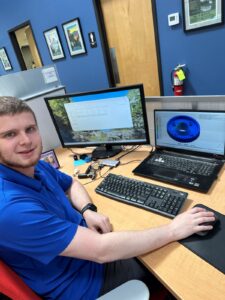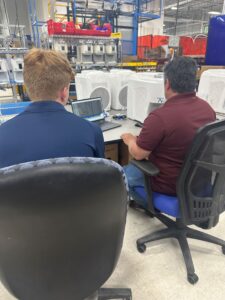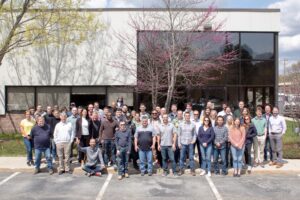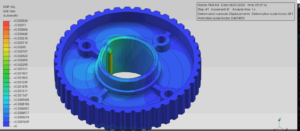Did you know that the majority of ColdSnap’s 70+ employees (as of the time of this writing – we are growing quickly!) are engineers? Sixty percent of ColdSnap is comprised of mechanical, electrical, manufacturing, chemical, software, quality, and industrial design engineers. Our innovative system includes a rapid freezing appliance, pods, and the software required to make ColdSnap’s technology run seamlessly – so a variety of engineers are crucial to the ColdSnap operation. We sat down with four of the engineering teams – mechanical, electrical, software, and test – to give you the scoop into their world. Are you ready to get to know the teams behind ColdSnap’s magical frozen treat appliance?
Discussions with Four Types of Engineers at ColdSnap
The different types of engineers are in constant communication with one another as they perfect ColdSnap’s technology and solve problems with the appliance or pods, as they arise. Each engineer is tasked with working on the appliance or pod, and their goals range from perfecting the pod to assembling and testing the ColdSnap ice cream and frozen smoothie system. Here is a peek into what a typical day looks like for four types of engineers at ColdSnap.
Mechanical Engineer

Jake working on a 3D simulation
Mechanical engineers make up the majority of ColdSnap’s engineering team. The mechanical engineers at ColdSnap design, test, and develop unique components, toward the goal of creating an innovative and efficient ColdSnap system (appliance and pods). While the components can be made in-house or outsourced, developing them at ColdSnap HQ helps speed up the process. You might be wondering how mechanical engineers make these components? Well, each engineer has their own method. The majority begin the design process with 2D hand sketches. After hand sketching, on the computer using 3D CAD software they build their designs into 3D models.
Designing in 3D is critical because it allows the engineers to conceptualize, visualize, detect interference between parts, monitor form, fit, function of their design in a larger assembly, and perform static and dynamic load testing. During the process, the engineers build unique tools and parts often using an in-house lathe/milling machine and 3D printers. The engineers can shape and fine-tune tools by hand. The final steps are to test the components and document the findings!
A closer look at the 3D simulation
Electrical Engineer
The electrical engineers at ColdSnap have a variety of tasks that set them apart from the other engineering departments. Their primary focus is the inner workings of the appliance. Electrical engineers create specifications for electrical components in the PC Board that controls the ColdSnap system and make schematic changes to the design as required.
Additionally, they troubleshoot any issues that arise. In doing so, they must first identify whether it is a mechanical or electrical issue. If it is an electrical issue they fix it, and if it is a mechanical issue, they pass it on to the mechanical team. You will often find electrical engineers in the lab. In the electrical lab, they use an oscilloscope or multi-meter to verify the electrical performance of components in the machine. There are frequent interruptions for urgent matters around the electrical engineering environment, so they must go with the flow and address things as they come up.
Jim working on an oscilloscope
Test Engineer
The test engineers at ColdSnap evaluate and test a variety of data. The lifecycle testing of the appliance is one of their main tasks. Lifecycle tests are a way of determining whether a machine can make it through its projected lifespan. Their goal is to make sure that the ColdSnap machine can churn out delicious ice cream and other frozen treats for many years without requiring maintenance. Most of the data analysis is captured during the life cycle tests of the ColdSnap ice cream appliance. When an issue is detected, the test engineers replace the part or find an engineer who specializes in that area. After resolving the issue, the test engineers’ job is to get the machine back into working order and continuing testing. The reliability of the appliance is paramount!
Another task of the test engineers is to run ice cream (and other products) testing. ColdSnap appliances are tuned to optimally freeze each product category; ice creams, Snappuccino™ frozen lattes, boozy ice cream, and frozen cocktails all have different codes that communicate to the machine how to freeze the product, when the product is sufficiently frozen, and when to dispense the product from the pod. The test engineers at ColdSnap love to spice it up and when the work is done, they enjoy a delicious frozen treat!

Test Engineers working on the machine
Software Engineer
The software engineers at ColdSnap ensure that all features and functions of the frozen treat system have been covered by the tests and that there are no gaps in the testing. They use a combination of testing techniques to ensure that the software is functioning as expected. During the testing process errors in the functionality can be found. The software engineers’ task is to detect and fix errors before releasing the software. Running tests and monitoring the ColdSnap appliance’s performance is of utmost priority. The goal of the software engineers is to design, develop, and maintain efficient and reliable software that meets the needs of users and stakeholders.
The Engineering Squad
Although there are different engineering departments at ColdSnap, they all work together as one chill team. The engineering crew is a vital part of the ColdSnap team, and their all-encompassing goal is a happy user. Looking for more information about the innovative ColdSnap system? You can find more details here!

The ColdSnap team
By Molly Ryan
Get the Scoop
Stay in the loop on all things ColdSnap with our newsletter.




